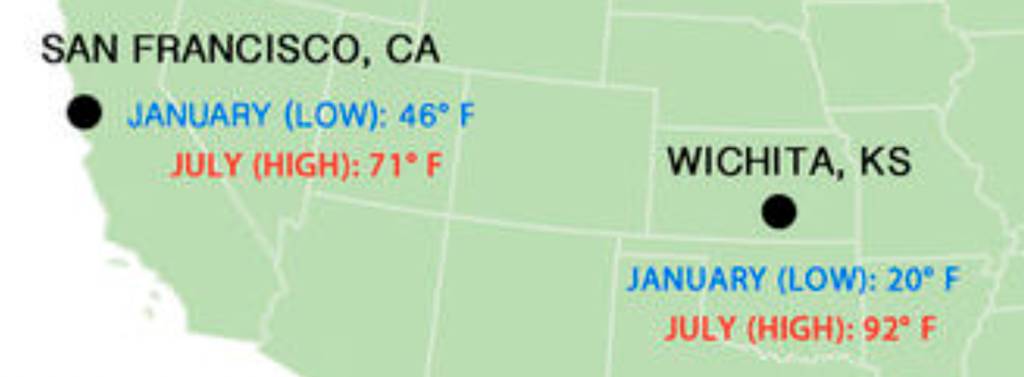The equator is located at _____° latitude, while the poles are located at ______° North and South.
0; 90
Which heats up AND cools down more slowly: Water or Land?
Water
Why do winds appear to curve instead of going straight?
Warm water/air rises because it is ______ _______ than cold water/air.
less dense
What is latitude?
Latitude is the distance of a place north or south of the equator.
What determines the temperature of an ocean current?
Where it comes from- warm ocean currents come from the equator, while cold ocean currents come from the poles.
What causes wind?
Wind is caused by the unequal heating of the Earth.
Warm air rises, and cool air blows in to fill the low pressure area left behind.
The height of an object above sea level is called ___________.
Elevation
Heat transfer that happens when warm, less dense fluids rise, and cold, more dense fluids sink is called ____________.
Convection
Based on latitude, which city would you expect to have the warmest overall climate, and why?

Dubai, because it is closest to the equator (0 °) which receives the most direct sunlight.
How does the Gulf Stream affect the east coast of the U.S. and parts of Europe?
The Gulf Stream warms these regions because it's a warm ocean current.
Wind moves from areas of _____ pressure to areas of ______ pressure
High; low
Mount Kilimanjaro is Africa's tallest mountain. It is located near the equator, yet its peak is covered in snow. Which climate factor best explains why this is possible?
Elevation; the higher up you go, the colder it gets
What is the difference between weather and climate?
Weather: the day-to-day state of the atmosphere; examples include rainy, cloudy, sunny, warm, etc.
Climate: long-term patterns of weather in a region; examples include tropical, temperate, and polar
Explain why Earth is warmest at the equator and gets colder the further away you move from it.
Due to Earth’s curvature, sunlight hits Earth at different angles. It is warmest near the equator because light hits the equator directly and intensely.
It is colder the further you move from the equator because these areas receive indirect, less intense light.
How does a place's distance to water affect its climate?
Places near water have moderate climates; the water makes it warmer in the winter and cooler in the summer.
Places away from water have more extreme climates (bigger temperature ranges between winter and summer).
Label the four blanks in the diagram linked below using the following terms:
Cold
Low
High
Warm
https://drive.google.com/file/d/1bK8Vwd0UPgbU5JO9V9gcBdaQZNl5VKlU/view?usp=sharing
Air Pressure over Ocean: Low
Temp over Ocean: Warm
Air Pressure over Land: High
Temp. over Land: Cold
Fill in the blanks:
Cold air sinking creates __________ air pressure.
Warm air rising creates __________ air pressure.
Cold air sinking creates HIGH air pressure.
Warm air rising creates LOW air pressure.
Why are winds and ocean currents important to life on Earth?
They redistribute heat around the world, so areas near the equator aren't as hot, and areas near the poles aren't as cold.
Why do latitudes where air is rising (such as the equator) often have a lot of rainfall?
These areas have lots of rainfall because when warm air rises, it eventually cools off and condenses, turning to clouds. From clouds, comes rain.
San Francisco, California, and Wichita, Kansas both have a latitude of 37°N.
What is the most likely reason for the average temperature differences seen below? Explain in full sentences with as much detail as possible.
San Francisco has warmer temperatures in the winter and cooler temperatures in the summer because it is near the ocean.
The ocean moderates the climate- acting as an "AC" in the summer and a "heater" in the winter since the ocean heats up and cools down more slowly than land.
Land heats up and cools down quickly, which is why Wichita has more extreme temperatures.
Explain at least one way that global winds affect climate.
Possible answers:
1. Global winds move AIR masses across the Earth. These can be warm, cold, wet, dry, etc. The type of air mass that is blown into a region helps determine its CLIMATE. When air masses collide, they create WEATHER.
2. Global winds create surface ocean currents, which redistribute heat around the world.
3. At latitudes where warm air is RISING, such as near the equator, we see a lot of PRECIPITATION. This is because the WATER VAPOR in the rising air will cool and condense, forming clouds, and then rain.
When and how does a sea breeze form?
A sea breeze forms during the day when warm air over the land rises, and the cooler air over the ocean blows in.
How is the precipitation and temperature of a maritime (coastal) climate different than that of a continental (inland) climate?
A maritime climate usually gets more rain because it's next to the ocean, and it has more moderate temperatures.